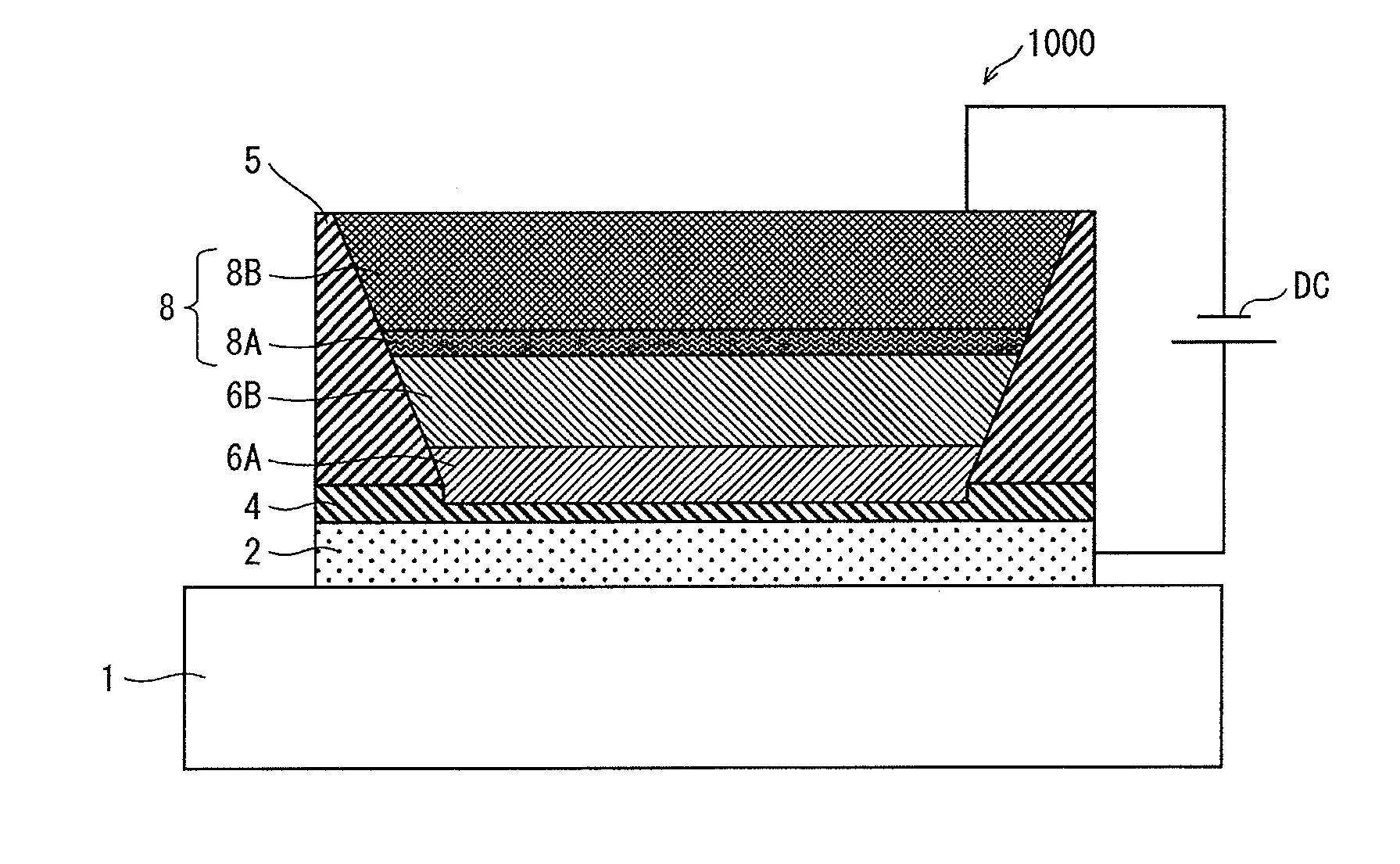Organic electroluminescence element
- Summary
- Abstract
- Description
- Claims
- Application Information
AI Technical Summary
Benefits of technology
Problems solved by technology
Method used
Image
Examples
embodiment 1
Structure of Organic EL Element
[0074]FIG. 1 is a schematic cross-sectional view illustrating the structure of an organic EL element 1000 pertaining to the present embodiment.
[0075]The organic EL element 1000 is an application-type organic EL element, which is characterized in that a functional layer is applied by a wet process in the manufacturing thereof. The organic EL element 1000 includes: a hole injection layer 4; a functional layer including various layers (a buffer layer 6A and a light-emitting layer 6B, in this case); and a pair of electrodes composed of an anode 2 and a cathode 8. The hole injection layer 4 and the functional layer are disposed one on top of the other, and are disposed between the pair of electrodes. Each layer of the functional layer contains organic material having a predetermined function.
[0076]More specifically, the organic EL element 1000 includes, as illustrated in FIG. 1, the anode 2, the hole injection layer 4, the buffer layer 6A, the light-emittin...
embodiment 2
Overall Structure of Light-Emitting Element
[0217]FIG. 16 is a schematic view illustrating a layered state of layers of a light-emitting element 1000C pertaining to embodiment 2. FIG. 17 is an enlarged view of a part surrounded by dashed-dotted lines in FIG. 16.
[0218]As illustrated in FIG. 16, the light-emitting element 1000C is a top emission type organic light-emitting element in which pixels corresponding to the colors R, G, and B are arranged so as to form lines or to form a matrix. Further, each pixel has a layered structure where various layers are layered above the substrate 1.
[0219]The light-emitting element 1000C differs from the organic EL element 1000 in embodiment 1 in that, in the light-emitting element 1000C, the hole injection layer 4 is disposed on an upper surface of an anode (the anode 2) with an ITO layer 3 interposed therebetween. In addition, the light-emitting element 1000C also differs from the organic EL element 1000 in embodiment 1 in that (i) the buffer laye...
embodiment 3
[0260]A light-emitting element 1000D pertaining to embodiment 3 differs greatly from the light-emitting element 1000C pertaining to embodiment 2 in that the ITO layer is not formed under the hole injection layer and that a protection film is formed on the hole injection layer. In the following, description is provided while focusing on aspects differing from embodiment 2 and while simplifying or omitting description concerning aspects that are similar to embodiment 2.
[0261](Structure of Light-emitting Element 1000D)
[0262]FIG. 24 is a schematic view illustrating a layered state of layers of the light-emitting element 1000D. As illustrated in FIG. 24, the light-emitting element 1000D includes an anode 102 formed on a substrate 101, and a hole injection layer 104 and a protective layer 110 that are layered on the anode 102 in the stated order. The hole injection layer 104 functions as a charge injection transport layer. Here, note that the hole injection layer 104 is formed across the ...
PUM
 Login to View More
Login to View More Abstract
Description
Claims
Application Information
 Login to View More
Login to View More - R&D
- Intellectual Property
- Life Sciences
- Materials
- Tech Scout
- Unparalleled Data Quality
- Higher Quality Content
- 60% Fewer Hallucinations
Browse by: Latest US Patents, China's latest patents, Technical Efficacy Thesaurus, Application Domain, Technology Topic, Popular Technical Reports.
© 2025 PatSnap. All rights reserved.Legal|Privacy policy|Modern Slavery Act Transparency Statement|Sitemap|About US| Contact US: help@patsnap.com



